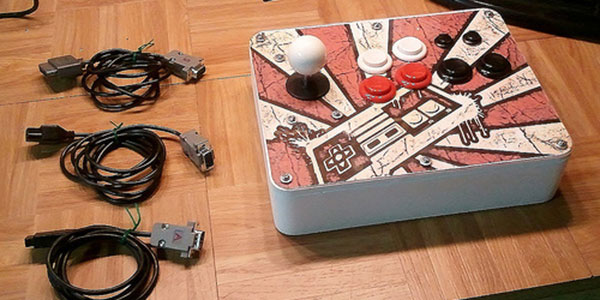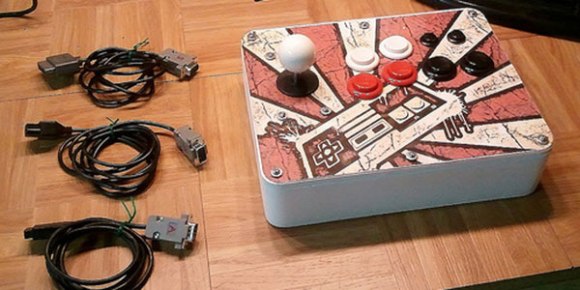[Dave Nunez] wanted arcade quality controls when gaming at home. The problem was he couldn’t decide on just one console to target with his build, so he targeted them all. What you see above is a single controller that connects to many different gaming rigs.
He took a simple-is-best approach, keeping the main goal of high-quality inputs at the forefront. To start, he built the face plate out of thick MDF to ensure it wouldn’t flex or bounce as he mashed the buttons. To keep the electronics as simple as possible he soldered connections to actual controller PCBs (well, reproductions of controllers), breaking each out to a separate DB9 connector on the back of the case. These connectors interface with one of the three adapter cables seen to the right. This lets the controller work with NES, SNES, and an Atari 2600 system.
To pull the enclosure together [Dave] designed the rounded corner pieces and cut them out with a CNC mill. These connect with flat MDF to make up the sides. To give it that professional look he filled the joints with Bondo and sanded them smooth before painting.

















Great choices in parts. This is one of the few controllers I’ve seen here that doesn’t make me (a longtime joystick modder) cringe :)
Can’t go wrong with a Sanwa JLF lever (IMO a lot better than the Zipppy stick everyone seems to go with, which is a knockoff of a Seimitsu LS32 anyway), but if he really wanted to use Sanwa buttons he could have gotten screw-in types.
If he wanted to have his controller work on yet more consoles, he could use a MC Cthulhu PCB: http://gdlk.co
i have seen lots of these and they seem a bit primitive
emulation is your best friend here! an AVR is more than enough to generate all necessary controller signals ….. use a VGA plug and have it feed back via jumpers what’s connected! … no risk of cross connection!
Very much this, thought not everyone knows how to program it’d earn more cool points if the cable told it what to generate via certain pins and it would jump into that controller types loop. Also atm there might be a mild risk of powering the other controllers up parasitically via the i/o protection diodes from button to button, but its working so oh well!
>Seen to the left
I dig this project, but I don’t understand the decision for the target platforms. This project screams “fighting game”, and while there are several on the SNES, there aren’t any on the Atari or NES. I understand the SNES, but not the other two. I’d have thought SNES, Genesis, and Saturn, tbh.
Bonus point of doing Genesis is that it also works with Atari.
Could have put just the shift registers in the D-Sub hoods, and used a 25-pin connector to connect all the buttons (DPad, 6 buttons, select & Start), and it doesn’t matter if the original controller circuit is common ground or an x/y matrix. Then you can connect nes/snes/saturn/atari/amiga/tg16/n64/aes/mvs or whatever just by swapping cables, bonus for not having 3 ports on the back of the joystick to figure out in the dark. You can squeeze out a few extra buttons if you assume some pairings will always be on the same matrix line, usually you can assume the dpad is all on one line, and the four primary buttons are on one line. that nets you between 3 and 6 additional buttons. if you implement the primary interface as a 4×5 matrix and thus use all 25 pins, you get 20 ‘buttons’ and can handle most of the existing controllers without resorting to emulation of the original chips.
Check also this project, which enables WII Nunchuk controller for the NES and SNES
http://www.hwhardsoft.de/english/projects/nunchuk2snes/
Ok, why not use this retro adapter: http://denki.world3.net/retro_v2.html?
You can also get a joystick made for Neo Geo. For some reasons, SNK decided to hard-wire every buttons in their joystick:
http://old.pinouts.ru/Game/NeoGeoJoystick_pinout.shtml
Also, I would avoid exposing any nuts or bolts on the front of joystick. When you are focused on a fighting game, you could cut your hands with the metal screws.